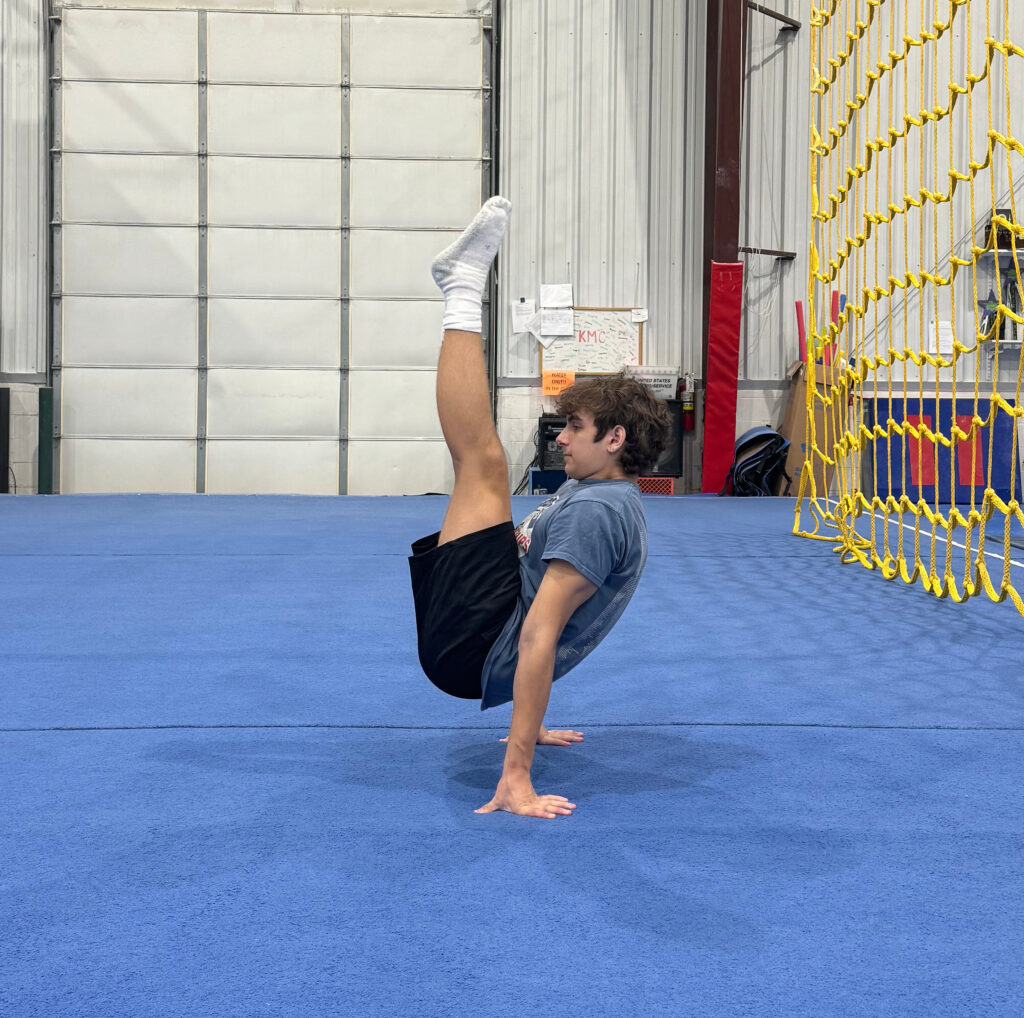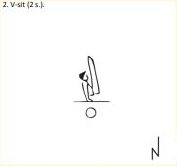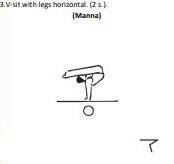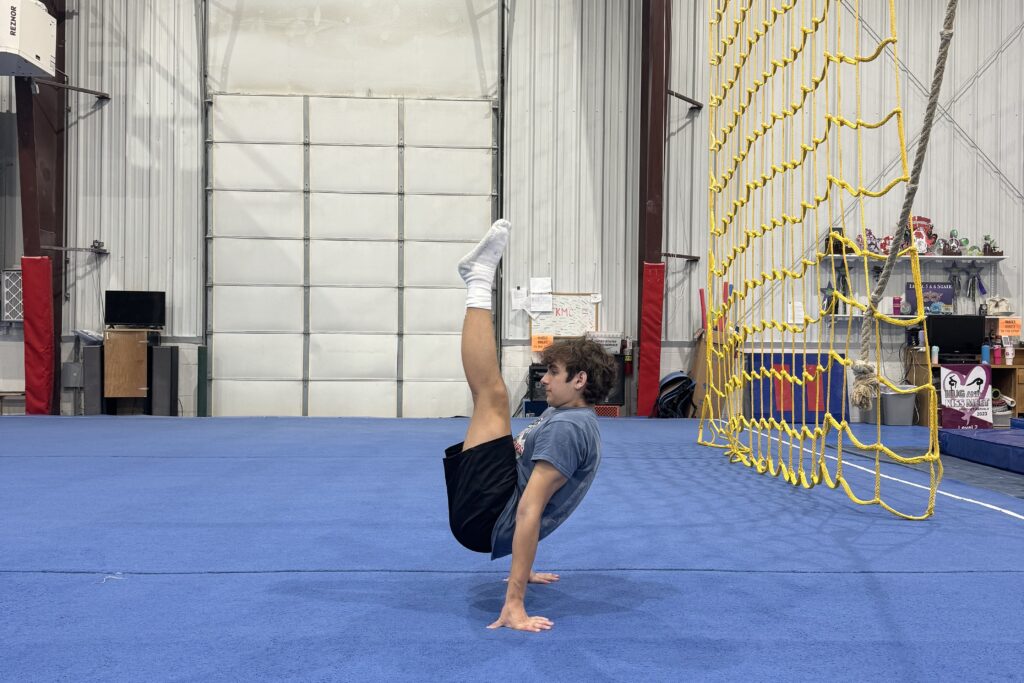The V-Sit is an extremely important strength element in Men’s Gymnastics. Typically, you think of the iron cross, maltese, or planche when it comes to difficult and impressive gymnastics strength skills. Not often do people look to the uncommon cousin of the L-Sit as a serious strength skill. However, training the V-Sit has some massive advantages that greatly benefit the gymnast.
What is a V-Sit?

The V-Sit is a strength skill where a gymnast is piked with legs straight vertical and hands in rear support lifting the body. An extension of the basic pike shape, the V is also a progression of an L-Sit and a regression of a Manna. As a skill for value, the V can be performed on Floor, Still Rings, and even Parallel Bars.
Role of V-Sit in Injury Prevention
Shoulder Injuries are extremely common in gymnastics. An article from SHIFT Movement Science outlines some research that indicates the prevalence and causes of shoulder injuries in gymnastics. The article highlights the prevalence of upper limb and specifically shoulder injuries in gymnastics. Similarly, the piece notes some contributing factors, such as the up to 9.2x bodyweight forces measured on rings. From personal perspective, I’ve observed many ring gymnasts with chronic shoulder problems and some of them have ended up with labral or rotator cuff tears.
Shoulder Imbalances from Gymnastics Strength Training
The cross and the maltese usually form the foundation of about half of an elite rings routine. Typically, four skills are some variation of cross or maltese. Most of the times these variations use the same muscle groups as well. An azarian to cross combines the shoulder flexion during a maltese with the typical strain of shoulder adduction during a cross. A butterfly, and all of the insane progressions of it, just extends the same range of motion of the iron cross.
Most of these exercises hit some combination of the chest, lats, anterior deltoid, and biceps. This combo, without proper correction, generally in a gymnast who is very front heavy. Usually, gymnasts underemphasize the lower traps, rhomboids, and posterior deltoid, key players in maintaining scapular health. The result is are gymnasts who have limited overhead mobility, external rotation, and shoulder extension.
Combatting these Muscle Imbalances with the V-Sit
The V-Sit is a key tool I believe can fight this shoulder imbalance. The V-Sit involves shoulder extension, retraction, and depression of the shoulder. Shoulder extension engages the lats, posterior deltoid, and the teres major of the rotor cuff. Retraction activates the trapezius and rhomboids. Finally, the lower trapezius plays a large role in depression.[1] All these muscles of the upper and middle back play a role in countering the muscular imbalances developed when typically training rings strength.
V-Sit Skill Transfer
Even beyond the clear shoulder health benefits of V training, the V-Sit carries over to other skills. Think about the typical bulky gymnast, who struggles with the pommel horse. They likely suffer many of the muscular imbalances mentioned before. A limited range of motion through extension and retraction results in a circle that lacks amplitude, where they pike in the hips and round through the chest. They also may skew to make their circles easier. Now, the V-sit trains that shoulder extension and retraction, and develops a solid base of mobility to build a nice circle. In my opinion, the V-sit is an effective tool in improving foundations for horse circles.
Similarly, this is helpful for the front of a swing on parallel bars. In a front swing, strength is not as necessary since most energy comes from momentum from the downswing. However, the V-sit, and its more difficult variation, the manna, extend the range of motion of the shoulder, allowing a more fluid front swing. Likewise, some of the best front dismounts are set up by a front-uprise that pushes right through a manna position.
Adding Difficulty to Routines

Beyond just biomechanical value of training, the V-Sit has standalone value when performed in routines. A V-Sit on floor is a very safe B value non-acrobatic element; you are not likely to get deducted on a decent V-Sit. Contrast this with a press to handstand, which junior gymnasts might perform with some steps and unsteadiness in their handstand. The V-Sit then extends into a V-Sit press and later to a manna press, C and D elements respectively. This same relationship can be seen on rings, where a V can increase the difficulty of many elements.
For a more information, check out our general overview of scoring in men’s gymnastics.
Training the V-Sit
Now that I’ve made my case as to why I think the V-Hold is so important, we can talk about training for it. I’ll start from ground zero here since I think this information could be helpful and relevant for young gymnasts and beginner bodyweight athletes.
First Step: L-Sit
The first big landmark in the path up to a V-Sit is an L-sit. A few physical preparation drills could be helpful in getting to an L-sit. Piked leg lifts on the floor are helpful in developing hip flexor and core strength. Another accessory is a swing to brief pause in L-Sit on parallel bars . The less momentum used in the swing up, the harder it will be. It is most important to focus on the lowering portion of the L-sit, so exercises starting in an L and resisting the legs dropping will be useful. Especially so, once the L-sit can be held for a couple seconds. The goal here should be a solid L-sit hold for 10 seconds.
Moving to the V
At this point, an athlete can start working toward a V-sit. For this, there are many drills. The main focuses are gaining strength through shoulder extension, and learning core compression. Two big helpers here are holding straddle or tucked V-sits (I personally prefer straddle). When confidently holding a straddle V-sit, trying to bring the legs together will start to bridge the gap to a true V-hold. I find that doing V-Holds or these variants are sufficient in learning a V-Hold.
Although those are sufficient, there are accessories that may help aid the journey. Continued pike leg lifts aids in core compression. Likewise, V-Sit wall slides are beneficial to shoulder extension, as are elevated reverse planks. Prone shoulder extension with dumbbells will also work the same muscle groups as a V-Hold. Like the L-sit, hitting a 10s V-sit hold is a sign the skill is solid.
Beyond a V-Sit: The Manna

Now for the ultimate reward, executing a Manna. This requires even more aggressive shoulder extension than a V. One way to think about training a manna is as a V but slowly progressing by tilting backwards past vertical until the legs are completely parallel with the floor. The aim here is to slowly gain V-hold range of motion toward that manna. I like to combine holding a V position for 3-5s at the end of comfortable range of motion with attempts to improve range of motion.
Some people might need to work on flexibility and mobility to allow the range of motion through extension to open up. Others might have the range of motion, but not the strength through that mobility. For those with mobility I like a similar method to how we learned L-sits; attempting to swing up to the end range and hold it. I do think it’s important to use mats here, since swinging up to a manna is going to cause you to throw yourself on your back quite often. The goal is to combine practicing static holds to secure strength through your range of motion, and the dynamic efforts to expand your mobility and build a base to establish strength through. Eventually, this will result in a manna
If you enjoyed this content or other content about Gymnastics Strength and Conditioning, check out our article about using Lengthened Partials for Gymnastics.

